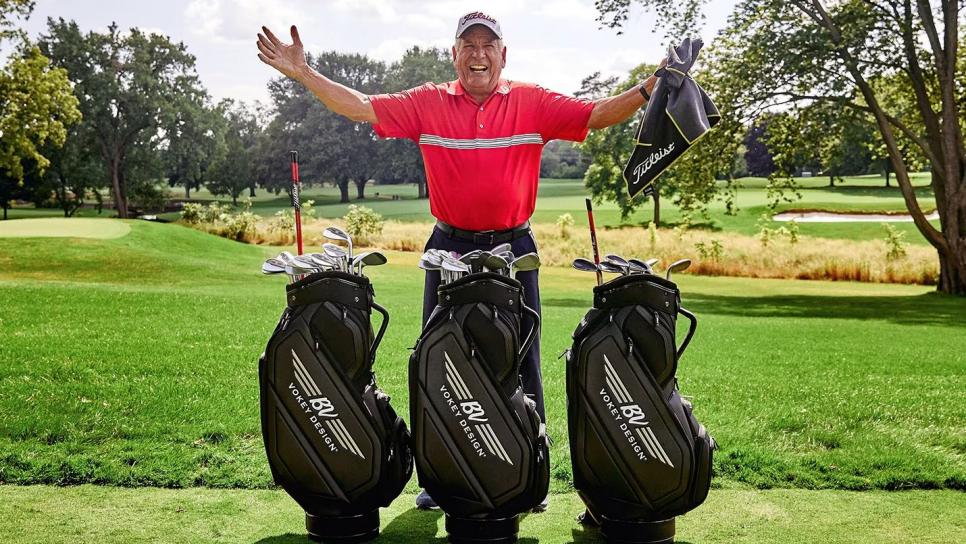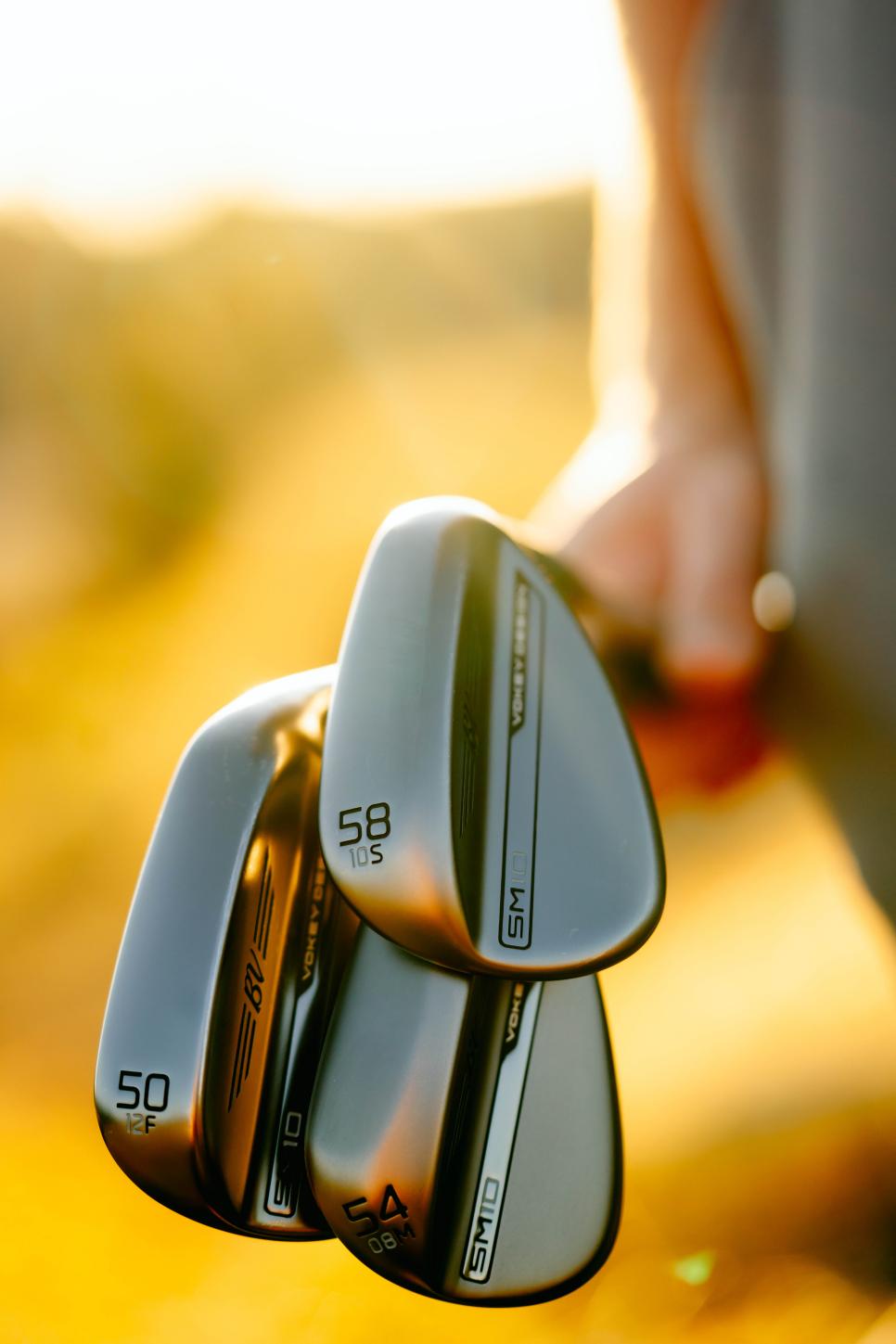The fascinating thing about Bob Vokey, the wizard of wedges who is 84 and still works out despite the aggravation of four back surgeries, isn’t how much he knows about the most underappreciated and misunderstood club in our bags. It’s how enthusiastic he remains when it comes to learning more from you—whether you are a tour player or a ham-handed 17-handicap—about how wedges can make us better in ways no other equipment change can.
That’s right, the man who by all accounts invented the modern wedge that’s now in its 10th iteration under the Titleist Vokey Design SM10 moniker, doesn’t necessarily want to pontificate to you about what he knows. He wants to see what you can tell him about the short game that he hasn’t thought about yet. Still, all the while as you go through a wedge fitting session with him, you are enlightened, and more importantly inspired by the enthusiasm of a man just watching you blade shots across one of the perfect greens at the Titleist Performance Institute, which is in the midst of a complete overhaul that includes a David McLay Kidd redesign of the range. That redesign will include a special Vokey area, the centerpiece of which will be a 13,000 square foot “Vokey green” that accepts and facilitates the full array of short-game shots that fuel Vokey’s curiosity and tickle his fancy— and make all golfers from PGA Tour players to those who just watch them, get better faster.
“This is the fun part of the game,” Vokey says, all inventive energy and eyes asparkle. “Why wouldn’t you want to spend more time practicing here than anywhere else?”
It’s a more than reasonable point as Vokey quickly relays how the typical driving range is chock-a-block with golfers turning themselves into knots with their full swings, while the short-game green, if there even is one, is as desolate as a Denny’s at 3 a.m on a Tuesday.

Photo courtesy of Titleist
What Vokey has perfected across the last three decades of working with the best players in the world on their short games is the art of seeing what’s not immediately obvious. Or rather, I think, having it revealed slowly and then quickly but ultimately, as it turns out, obviously. He is infectiously curious to find what might work, whether it’s one of the ways he’s already figured out how to shape a wedge or how he’s relayed to the engineers at Titleist what the best players in the world are telling him about feel and launch and spin.
That work of watching is what otherwise might be known as a wedge fitting, but it is a rare sight even in today’s golf equipment universe, where fitting almost has become standard operating procedure. Except it really hasn’t happened in wedges. Less than 20 percent of avid golfers say they are fit for their wedges, with barely a third saying it’s even “very important,” according to studies by Golf Datatech.

Photo courtesy of Titleist
Of course, wedge fitting in the last decade has become more and more complex as lofts, bounce options and sole grinds have proliferated more than golf social media influencers. And while fitting wedges indoors is at best an approximation (Titleist’s efforts here are noteworthy, of course), the real way to get fit for a wedge is the way Vokey does it still. In the dirt, searching, counseling, encouraging.
Obviously, it’s the way you should do it, too. As I blundered my way through my session with Vokey and Titleist wedge-fitter Brandon Rheault patiently guiding each step, certain guidelines became apparent. And they are doable for anyone who wants to understand how the right wedges make you a better short game player. (A Vokey Experience wedge fitting is available to the public, too, as our Alex Myers so vividly detailed here. But the man is busy so get on the schedule as soon as you can.)

In the meantime, from being in his presence for an afternoon, which, as you might have guessed, is as much educational as it is restorative and (obviously) fun, here’s what I gathered as some of the most important things Vokey thinks you should think about your wedges.
1. The wedge is vital and easy for any player
The wedge sets up everything and anyone can be better at it. “Everybody has the clubhead speed to be good with their wedges,” Vokey says. “Not everybody can hit it 300 yards, but this is going to matter more.” The point is while the right wedges will help your game—and the wrong ones (in terms of loft and sole design and shaft) will most definitely short-circuit it—you ought to spend more time working on the short game. If you’re good in the short game, it puts less pressure on your approach shots and even less pressure on your putting. And, of course, like he says, “this is the fun part.”
2. Try wedges blindly to see the light
Much of a wedge fitting should be completely agnostic, what Rheault called a “blind grind” test. In other words, the less you know about the potential change in loft or bounce or sole grind or even shaft you’re considering as you hit shots, the better. You don’t need to know everything when your optometrist keeps asking you “Better or worse?” Same applies to a wedge fitting. Go with your immediate gut reaction, but delve no deeper. Rheault, like Vokey, would often hand me a wedge with the grip thrust into my hands and the head hidden. “You’ll know when it’s wrong and when it’s right,” he said. “The right one will just feel easier, less catching and grabbing in the turf.”
It’s tempting to throw up your hands at Vokey’s seven different grinds (or Callaway’s five or Ping’s six or Cleveland’s four or TaylorMade’s seven) and the indecipherable letters and numbers that describe how soles are shaped or how much the leading edge sweeps back and away from the trailing edge. You cannot get what those names mean through a description of heel and toe relief, medical-grade illustrations or even a video. (Basic tip: You want less bounce if you take little to no divot, and more bounce when your divot is more full-sized, but that’s a crass generality.) Rather, you just have to hit shots. As Vokey has long said, “you don’t find the grind, the grind finds you.”
It’s classic Vokey, of course, when he tells me that his famous phrase came not of his own surmising but from a clinic he was conducting in Denmark where one of the participants came up to him at the end of a long session of searching through the latest wedges, trying to discover the right sole shape, realizing ultimately that trial was the best teacher: “I did not find the right grind, Mr. Vokey, it found me.”
RELATED: 2024 Golf Digest Hot List—Best wedges
3. Hit all the shots before you decide
The right wedges need to be versatile so to find the right model you need to hit shots from multiple situations, especially the ones you might find most difficult. With the right wedge, turns out those nettlesome situations may not be such a bother. “You have to look at wedges as tools,” Vokey says. “You need the right tool for the job.” As you go through the litany of shots you need to hit, Rheault would immediately sense where each option belonged in a pecking order for each situation—and upon the barest of reflection, so did I. The right wedge, of course, is the one that tends to be around the top of the pecking order in most situations.
RELATED: Grind vs. Bounce, two important wedge concepts explained
4. Know your yardage gaps
An app like Arccos or even a general awareness of how your wedges adequately fill your yardage gaps is crucial. A gap of 12-15 yards and 4-6 degrees of loft per wedge is a good starting point, but the point is to know before you start any kind of a fitting. Know, as well, whether you even make any full swings at all with your highest-lofted wedge. Data is your friend, guessing usually gets you in trouble. On full swings and even partial ones, focus on clean contact where ball meets face most crisply. Rheault and Vokey talked specifically about finding the ideal impact between the second and fifth groove from the bottom. Like a great ice-cream place in a new town, I don’t have the ability to know where that is ahead of time, but I know when I’ve been there. Turns out, every time I felt good about contact, there was the evidence right in those grooves. More consistent contact there means the shaft and grind are working to optimize those distance gaps.
5. Rethink loft on your bunker club
Your highest lofted wedge, what many call a lob wedge may not always be your best bunker club. Vokey likes to call 54- and 56-degree wedges by their original names “sand wedges.” With the right bounce (generally more than 10 degrees), these clubs can be more effective across a range of bunker shots than a 58- or 60-degree wedge, Vokey says. “When you get in the bunker and those hands start to get a little lower, that extra bounce is going to help in the bunker,” Vokey said.

David Cannon
6. Don’t overlook the shaft
While the stock shaft in a Vokey wedge is a relatively heavy Dynamic Gold S200 steel shaft, that doesn’t mean it’s mandatory. A lighter more flexible shaft that aligns with your iron specs may make for an easier transition to this part of the bag. That said, Vokey still believes steel provides the best feel, including a marginally heavier shaft than what’s in your irons. The thinking is that more weight will help to make the club easier to control on those shortest shots, where something ultralight may create more speed in your move than you need. A good rule of thumb might be 10-15 grams heavier than your iron shafts, and only on the sand and lob wedges. Because it is almost exclusively a full-swing club, a third wedge, or gap wedge, which fits between the lofts of your pitching wedge and sand wedge, probably should match the shaft in the rest of your irons. In my case, on the higher lofted wedges, my particular 95-gram graphite iron shaft with a Regular flex matched up well with a particular R-flex steel shaft at 110 grams. But Vokey and Rheault had me try at least half a dozen models before we got the delivery, consistency and feel that produced the best results.
Golf Digest Hot List: The best wedges for greenside shots for all handicap groups
7. Watch your flight
Particularly for all but the slowest swinging and highest-handicaps, find a wedge design that easily yields a controllable flight that’s slightly lower rather than higher. When struck correctly, those flatter trajectory shots will tend to spin more and that lower flight will be less affected by the wind. (This is mainly true if you’re using a multilayer urethane-cover ball. If not, even the best-fitting wedge isn’t going to produce a lower or even remotely consistent flight. We recently ran a robot test of 65 different golf balls with the team at Cool Clubs for a 45-yard wedge shot. Those with urethane covers launched the ball an average of four degrees lower than balls with the less-expensive—and lower-spinning—ionomer covers.) The name of the game with wedge play is precise consistency. If you need more height with your wedges, I’d suggest what you probably need is either an extreme game-improvement wedge or another way to generate more speed through a lighter shaft.

RELATED: The truth about wedge bounce is staring you right in the face
8. Be thorough but know when you know
If you leave three straight shots in the bunker with a particular wedge, it isn’t just you, it’s the wedge. Of course, when you blade three in a row over the green, it really just might be you. That said, a different sole might immediately change those results. But it should be fairly immediate. Hitting all the shots should be short and obvious work. And the more time you spend with a particular wedge or grind, the more you can adjust your game to it. You’re looking for love at first sight.
A good way to tell that you’re getting what you want is to pay attention to how the ball reacts on the green. If shots are checking but stopping well short of the hole, pay more attention to the checking than how short or long you are from the pin. The former points to consistency of contact, the latter is just the mathematics of matching the length of your swing to a particular distance. That will come with time, because like Vokey says, practicing your short game is the fun part. Or it will be now that you’ve got the right wedges.
This article was originally published on golfdigest.com



